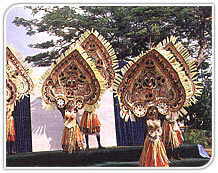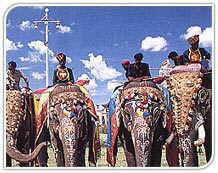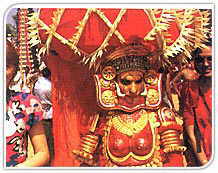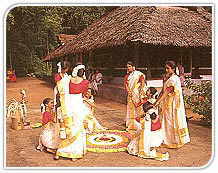 Home
>>States
>>Kerala >> Folk Music &
Dances
Home
>>States
>>Kerala >> Folk Music &
Dances
Kerala : Folk Music & Dances
Theyyam

Theyyam
is one of the most outstanding folk arts of Kerala and has its origin in
the northern parts of the state. Also called Thirayattam, (because every
thira or village performed this ritualistic art at the village temple)
this primitive ritualisic art demands long hours preparation before the
performance.
TheTheyyam (a form or shape) represents a
mythological, devine or heroic character. There are over 350 Theyysma in
northen Kerala. The hood, headdress , face painting, Breast plate,
bracelets,garlands and fabric of attire of each of these Theyyams are
distinct and meticulously crafted according to the character presented.
Musical accomaniments are chenda and veekuchenda (drums), elathalam and
Kuzhal(horn). This art form is mostly performed in Bhagavathy temples.
Performances are on between october and May. Thira is the main subdivision
of Theyyam.
Cherumarkali
is a harvest dance in which the dancers, both men and women move in a
swift rhythm, linked in a back lock or holding arms. The costumes are in
striking red and white.
Kaalavela is a spectacular
procession of huge, gaudily decorated motifs of bulls (kaala.)
Kalampattu
(kalamezhuthu pattu) is another folk art form that belongs to the
northern regions of Kerala. This art form which is over 600years old is
performed by a group of five to fifteen people in Bhadrakali and Ayyappa
temples. The rituals is performed around the kolam -an elaborate picture,
usually of Bhadrakali, drawn on the floor, using five colours. The
performance in the light of temple torches lasts through the night. The
singers are neatly dressed with women wearing their hair on the side of
the head. A series of songs (kalampattu) are sung to the accompaniment of
nanthuni and elathalam.
Kalaripayattu is the
comprehensive system of martial arts if Kerala, regarded as one of the
oldest and most scientific in the world. Kalaripayattu training aims at
the ultimate co-ordination of mind and body. The traditional training in a
Kalari includes specialisation in indigenous medical practices too.
Kalaris are also centres of religious worship.
 Kaliyoottu
is an eight day long colourful folk ritual which re-enacts the combat
between goddess Durga and the demon Darika. The ritual is performed in
different stages. The climax of the play- the ritual called paranettu- is
performed on a specially constructed 100 feet high stage on the eight day.
Kaliyoottu
is an eight day long colourful folk ritual which re-enacts the combat
between goddess Durga and the demon Darika. The ritual is performed in
different stages. The climax of the play- the ritual called paranettu- is
performed on a specially constructed 100 feet high stage on the eight day.
Kanniyarkali (Deshathukali) which is a ritual art and a
swift dance form, performed to the accompaniment of devotional folk songs
and the resounding drum beats is usually performed in Bhagavathy temples.
Kavadiyattam is a ritual dance offering in Subramanya
temples. The group of devotees wearing bright yellow or saffron costumes
with ash smeared all over the body, dance in a frenzy carrying Kavadis on
their shoulders. Kavadis are colourful bow shaped wooden structures rising
six to ten feet high. The ambalakavadi is structured and decorated like a
temple. The Pookavadi has clusters of colourful paper, cloth or plastic
flowers arranged on them. The resounding beats of percussion instruments
like udukku and chenda and the nadaswaram are characteristic of the kavadi
procession.
Kettukazhcha is a spectacular pageant of
colourfully decorated effigies of gods and goddesses, and images of
animals like the horse, bull etc.
Kolkali is a group
dance form of the farming community in Kerala. Twelve to twenty four
dancers move rhythmically in a circle around the ceremonial lamp, tapping
the two feet long wooden sticks held in their hands.
Kummattikali
is a temple folk art and an awe inspiring mask dance.
Kumbhamkali
/ kumbhamthullal (pot dance) is a folk ritual dance of devotees carrying
pots on the head.
Kuthiottam is a ritual art exclusive
to the Devi temples of south Kerala. A team of artistes perform this song
and dance ritual. The songs include those in praise of Durga and other
deities, Padapattu (war songs) and Kalaripattu (martial art songs).
Instrumental accompaniments are mainly percussions, ganjira, bells and
chaplankatta. Faces are painted and red curtains are used as partitions on
the stage.
 Pooram
is the great elephant pageant of certain temples in Kerala. Bejewelled
tuskers numbering ten to hundred, line up for this exotic spectacle with
mahouts siting atop them carrying the muthukuda (tinsel covered silk
parasols) and waving the venchamaram (white tufts). The pageant is
accompanied by the panchavadyam which gradually works up to a crescendo.
The most fascinating aspect of the pooram is the Kudamattom ritual, the
ceremonial synchronised changing of the colourful parasols held aloft the
elephants.
Pooram
is the great elephant pageant of certain temples in Kerala. Bejewelled
tuskers numbering ten to hundred, line up for this exotic spectacle with
mahouts siting atop them carrying the muthukuda (tinsel covered silk
parasols) and waving the venchamaram (white tufts). The pageant is
accompanied by the panchavadyam which gradually works up to a crescendo.
The most fascinating aspect of the pooram is the Kudamattom ritual, the
ceremonial synchronised changing of the colourful parasols held aloft the
elephants.
Mamangam (the term today describes any
endeavour that is reckless and expensive). This festival is a replication
of the cultural extravaganza held every 12 years by the zamorins of
Malabar in the middle ages. Royal families, principalities and chieftains
from all over Kerala used to participate in this great cultural event
which was held on the grounds of the Thirunavaya Navamukunda Temple at
Ponnani in Malappuram.
Mayilnritham/Mayilattom is a
ritual art performed by artistes in peacock costume. It is performed in
Subramanya in south Kerala. Oppana is a Muslim bridal group dance.
Padayani
(literally, a column of army) is a colourful ritual art which is symbolic
of the victory march of goddess Kali after she defeated the demon Darika.
The elaborate costume of this art form bears slight resemblance to
Theyyam.
Poothamkali (pootham) is a folk art more
commonly performed in the Bhagavathy temples of Malappuram. Pootham is the
character who accompanied Durga in her combat with Darika asura. The
performers, usually three in number, undergo a week of austerity before
the presentation. Colourful and intricately designed masks carved out of
the pala and murukku trees are the highlights of the attire. The fifteen
minute performance starts slowly and works up to a frenzy towards the end.
The thudi provides rhythm to the dance which is usually rendered at
night.
Pulikali also known as kaduvakali is a common
sight in Kerala during festive seasons. Performers painted like tigers in
bright yellow, red and black, dance to the loud beats of percussion
instruments like the udukku and thakil.
Sarpa pattu
(sarpam thullal) or snake dance is a ritual art performed in shrines and
temples devoted to Nagaraja the king of serpents. It is performed by women
who belong to the Pulluvar caste, in a specially decorated pandal, before
the sarpakalam (snake designs on the floor). The women dance in a frenzy
to the rhythm of the sarpa pattu, until they fall down exhausted. The
sarpa pattu is performed to the accompaniment of veena, kudom and kaimani.
 Thattumelkoothu
is a devotional folk art. The dance is performed on a special platform
which carried around the temple by devotees even as the performance goes
on.
Thattumelkoothu
is a devotional folk art. The dance is performed on a special platform
which carried around the temple by devotees even as the performance goes
on.
Thidampu Nritham which is over 700 years old, is a
ritualistic art form of North Kerala. The dancer moves to the rhythmic
beats of the chenda carrying the thidampu (the idol of the deity) on his
head. Seven artists accompany him on percussion instruments while two
others hold aloft the ritualistic lamps. The artiste wears much jewellery
and a decorated turban known as Ushnipeetam.
Thiruvathirakali
is a dance form which is a pointer to the old customs followed in Nair
tharawads (joint families) where the women of the house dance elegantly
around the ceremonial lamp or floral decoration on festive occasions to
the accompaniment of the Thiruvathira Pattu (song).
Thiyyattu
is a devotional offering to Bhadrakali and Sree Ayyappa. This ritual art
is performed in a specially decorated pandal, before the Kalam (five
colour design on the floor), the traditional lamp (nilavilaku), and peetam
(stool). The performance usually starts at dusk. The artists sing and
dance to the rhythmic music of the chenda, elathalam and chengila. The
costumes bear resemblances to Ottanthullal and Kathakali, the distinctive
features are huge jingling anklets and face makeup with tiny white dots.
Tholpavakoothu which is said to have originated in the
18th century is also known as pavakoothu (puppet play) or nizhalattam
(shadow play). This entertainment art is performed on a special stage
called koothumadam in the temple courtyard. Puppets (pavakal), usually
representing four characters from the Ramayana, are arranged behind a long
white screen, in front of bright wick lamps. The puppets made of deer skin
are made to dance to songs from the Kamba Ramayana (the Tamil version of
the epic). The performance starts late at night and continues up to
daybreak.
Vadithallu is almost similar to Kolkali and is
a folk dance in which artistes tap the short sticks held in both hands.
 Velakali
is one of the most elaborate and spectacular martial folk arts of Kerala.
This ritual art form is usually presented within the temple premises and
is called Thirumumbil vela when performed before the deity and Kulathivela
when performed near the temple pond. Fifty or more performers in the
traditional attire of soldiers, bearing colourful shields and swords or
long canes, dance with war like steps in perfect orchestration with the
resounding rhythm of the thakil, suddha maddlam, elathalam, kuzhal and
trumpets. A few fighting techniques of Kalaripayattu are also displayed in
the course of the performance.
Velakali
is one of the most elaborate and spectacular martial folk arts of Kerala.
This ritual art form is usually presented within the temple premises and
is called Thirumumbil vela when performed before the deity and Kulathivela
when performed near the temple pond. Fifty or more performers in the
traditional attire of soldiers, bearing colourful shields and swords or
long canes, dance with war like steps in perfect orchestration with the
resounding rhythm of the thakil, suddha maddlam, elathalam, kuzhal and
trumpets. A few fighting techniques of Kalaripayattu are also displayed in
the course of the performance.
Koothambalam: Special
hall in the temple premises for ritual and classical art performances.
Koothumadam: Stage specially erected for certain ritual
and classical art performances in the temple.
Special
Offers on Hotels & Resort Booking in Kerala
Travel
Agents & Tour Operators offering Travel Packages to Kerala
Kaliyoottu is an eight day long colourful folk ritual which re-enacts the combat between goddess Durga and the demon Darika. The ritual is performed in different stages. The climax of the play- the ritual called paranettu- is performed on a specially constructed 100 feet high stage on the eight day.
Pooram is the great elephant pageant of certain temples in Kerala. Bejewelled tuskers numbering ten to hundred, line up for this exotic spectacle with mahouts siting atop them carrying the muthukuda (tinsel covered silk parasols) and waving the venchamaram (white tufts). The pageant is accompanied by the panchavadyam which gradually works up to a crescendo. The most fascinating aspect of the pooram is the Kudamattom ritual, the ceremonial synchronised changing of the colourful parasols held aloft the elephants.
Thattumelkoothu is a devotional folk art. The dance is performed on a special platform which carried around the temple by devotees even as the performance goes on.
Velakali is one of the most elaborate and spectacular martial folk arts of Kerala. This ritual art form is usually presented within the temple premises and is called Thirumumbil vela when performed before the deity and Kulathivela when performed near the temple pond. Fifty or more performers in the traditional attire of soldiers, bearing colourful shields and swords or long canes, dance with war like steps in perfect orchestration with the resounding rhythm of the thakil, suddha maddlam, elathalam, kuzhal and trumpets. A few fighting techniques of Kalaripayattu are also displayed in the course of the performance.
